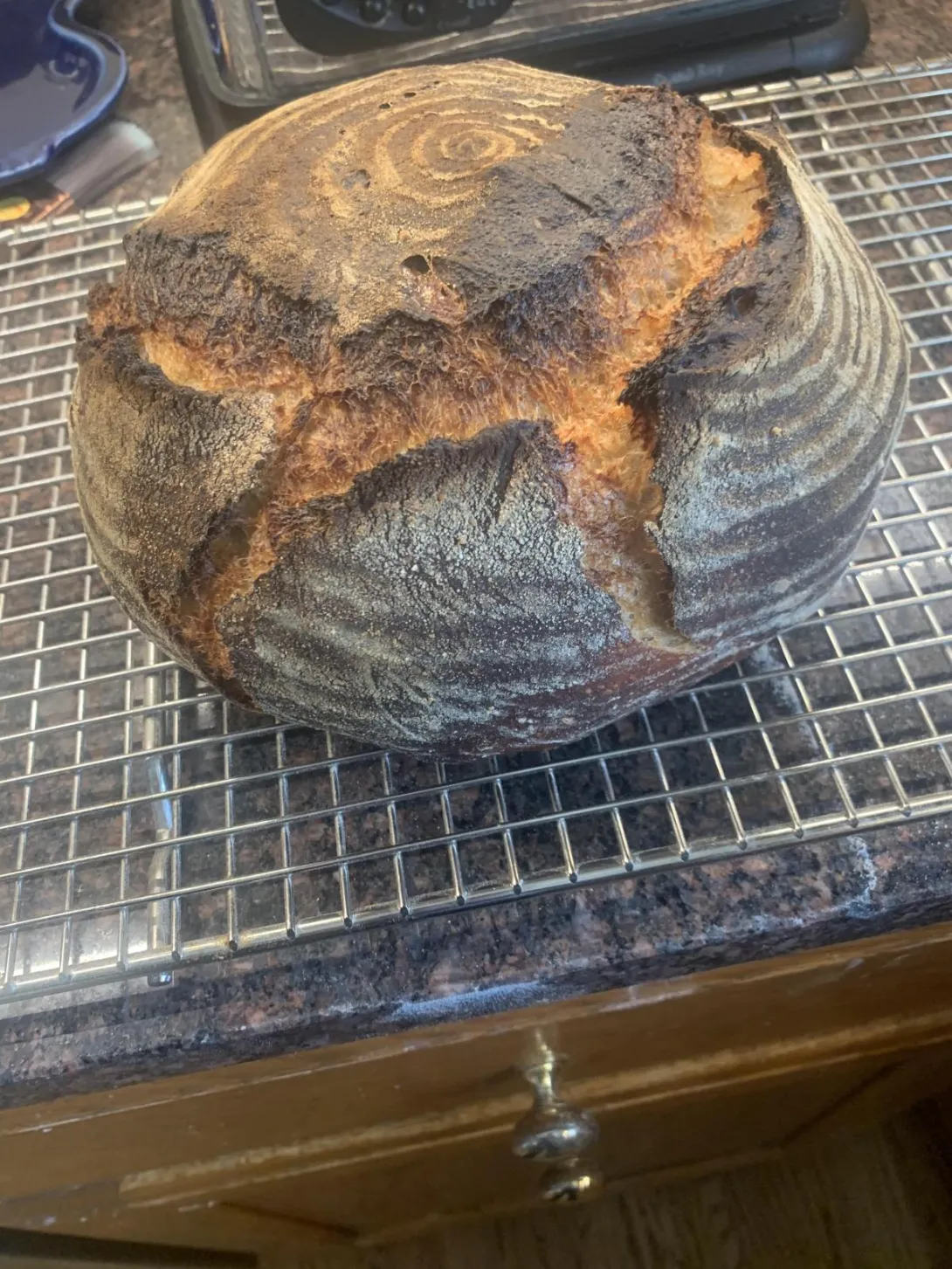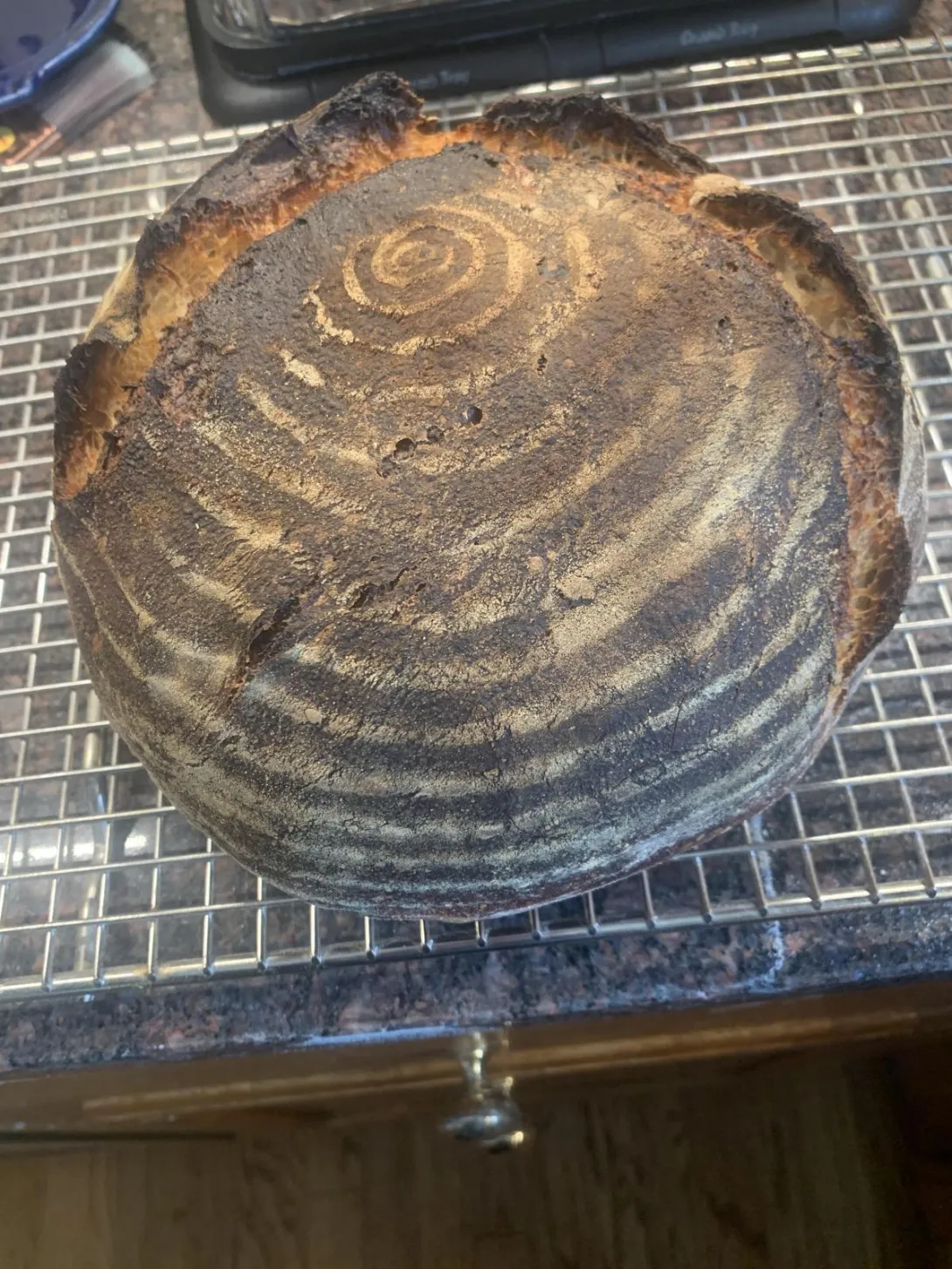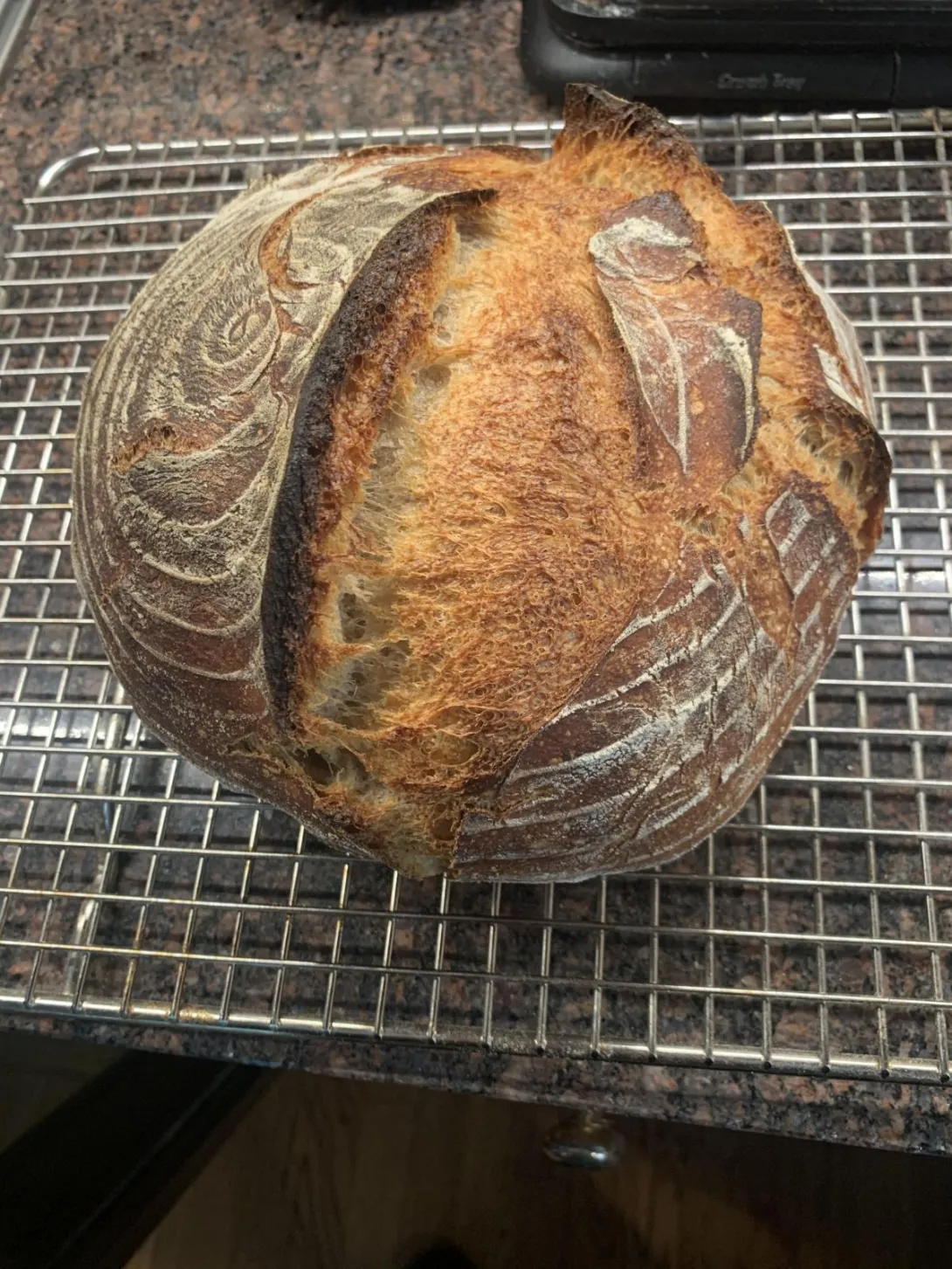
Image

Just wondering if any of you have thoughts on the convection baking or regular bake settings on your oven. I feel like the final bake of my sourdough gets brown within 10 minutes after taking cover off combo cooker. Is there a advantage to slowing it down? I use the FSWY methods. Just completed a Overnight County Brown. The recipe calls for a chestnut shade to it’s crust. I was hesitant to leave this loaf in any longer for fear of burning it too much. Thoughts?
Convection is usually bad for uncovered loaves.
Actually more important than whether the fan is on/off, is the location of the heating element used. Bread does not usually like to be exposed to the 1000+ dF radiant heat of an electric element. That is what makes toast.
top electric heat + fan + covered loaf can be fine -- no direct radiation.
Top electric heat + bare loaf = bread killer (or toast-maker).
--
And.... because dark surfaces absorb radiant heat more than light colored surfaces, the browning/blackening effect accelerates once it starts. It is fast and will burn before you are aware.
Thanks for the very thorough response. Looks like there is a fan at the back of the oven but there are coils on the top to provide heat. The fan runs all the time when on this mode. So now I have to determine how heat is produced on just a bake mode. Appreciate it.
Convection is what traditional ovens use.
Your issue sounds like the concentrated convection heat.
Perhaps if you put a caste iron tray close to the top element, that way, the caste iron would distribute the radiated heat. Caste iron both absorbs radiated heat and also it radiates the heat as well. With a caste iron tray you'd get an even source of heat from the cast iron tray at the top of the oven.
If you had a bottom element you could use a second cast iron tray to do the same thing.
I was wondering if could reccomend a cast iron tray?
Hi Melbourne Park,
So I baked another batch of Overnight Country Brown and put large pizza stone on the top rack so shield the exposed loaf from the intense heat. I also watched it very carefully. Both loaves turned out well. No burning like the previous loaf except for the ears. I pulled the loaves 15 minutes in. Thanks for your suggestion. The image attached is using your suggestions.
Image

Hi Paul,
Sorry I did not respond about a recommendation. I am in Australia, so I would not have been useful.
I note here though, that people recommended pizza stones etc and they do radiate heat! And they absorb heat of course.
I think though that caste iron would save some energy compared to a stone. The reason why I say this, is because caste iron both absorbs heat very rapidly, but it also radiates heat very well. So IMO if one turned on the top and bottom elements, the caste iron would both absorb and radiate quite efficiently.
I am not sure where you live, but in Australia, BBQs are popular, and they often have caste iron plates in them. And they are quite low cost. So if they fitted onto an ovens open pattern rack, one on top and one on the bottom, and the caste iron plates were put on those, I think it would be efficient.
However, since the Pizza tray worked, you don't need the caste iron!!! Since a Pizza "stone" would not absorb heat as quickly as caste iron, I presume that would result in them being often cooler than a caste iron tray sitting near a heating element. Which I guess, would be better for pizza. But for radiating heat, I think caste iron is great value and very effective.
Of course, once ovens were made that way - with lots of caste iron. They cooked very well. Some still are made that way, but they are costly.
Doug
If you know someone with a Flir thermal camera (they fit onto one's mobile phone) then it would be worth borrowing one and taking a photo of the oven. They show the various temperatures inside the oven. Any such device might help baking bread I reckon. However, as you showed, the bread tells its own story as well!
Cheers
Doug
Hi Dave
I tried some of the suggestions in this thread and it was successful. Convection as a rule bakes quicker. So I tried a large pizza stone and that appeared to really help the black burning. I also watched it very carefully as you suggested and pulled at 15 minutes. See image below - I think the shield and pulling sooner helps.
When I had my home-based micro-bakery, I always used convection mode. Otherwise I would not have been able to bake batches of 4-6 regular sized loaves on 2 tiers in my residential oven at a time.
Over the years, I had experiences with 3 different ovens (Jennair, Samsung, and Bosch) for some I had to adjust the temperature a bit, but they all worked well.
I used a steam pan and baking stone (to hold the temperature, not to directly bake on), and rotated the baking sheets after half the baking time.
If I had listened to advice saying it doesn't work there never would not have been a successful "Karin's Bäckerei" for more 10 years in Bar Harbor.
Happy convection baking,
Karin
Hi Karin,
I'm really interested to hear about your experience using a home-oven for a (tiny) commercial business. I've read some warnings about how running a home range for 10-12 hours per day at near-max heat can make them break way sooner than they would otherwise... what did you find? Also, were you able to get good steam? My range is gas, which is purportedly terrible for steam. What was your max loaves per hour, and what kind of bread did you find to be the best for you and your business (an intentionally vague question-- interpret as you will!).
Thanks for any & all insights on this.
-NBB
I sold my breads via our local natural food store. They wanted rustic baguettes, pitas or rolls, and another kind of bread, all those were "baker's choice" and changed every week. The amounts they could sell were limited, so it was not a big operation, every batch about as much as would fit into my oven (6-8 baguettes, 8-20 pitas or rolls, 4-6 medium-sized loaves).
My oven could handle all that well, but it had to run only for about 4-5 hours a day. I created steam with an aluminum pan filled with pebble stones, and boiling water (1 cup). My oven was well insulated, so steam did not escape.
I always had electric ranges, not gas.
I would mix all doughs the day before, and bulk ferment them in the fridge (I had an extra fridge in the basement), so that I didn't have to get up in the wee hours - the natural food store wanted the breads around noon.
Since you always have to wait until your oven heats up again after removing one load of breads, I started with the ones that baked at the highest temperature (baguettes).
In order to fit several loaves at a time in your residential oven, you have to keep them medium-sized, mine were about 800 - 900 grams each.
My price calculation was 3 times my cost of goods, rounded up to what the owner of the store told me she could maximally charge (her mark-up deducted).
The whole thing was, as you can see, not to make money, that would have required a much more substantial operation (selling breads to restaurants etc). I made a little bit of money, and could deduct the costs from our taxes.
I did it mainly for my entertainment - I enjoyed myself hugely - and to give back to the community - my breads always sold out.
That sounds like a lot of work! I can’t imagine what your schedule looks like. What kind of oven do you have to take that kind of abuse? : ) I was up in Bar Harbor a few years ago and suspect they take everything you can produce,. Perhaps it’s time to expand.
Not too bad, a good quality residential oven can handle being used all morning.
This is really invaluable, hanseata. Thank you! That sounds absolutely right, the point you make about doing it mainly for enjoyment (and a tiny bit of profit) vs. actually trying to make 'real' money... it's not a gradual increase, it's a quantum leap -- in terms of equipment, time commitment, funds invested, and etc. -- from the former to the latter. Certainly has given me a lot to think about.
Yes, to turn that into a more lucrative enterprise you have to supply restaurants, and, also, sell value-added baked goods, like sandwiches and other lunch items. Bread alone is not profitable enough unless you churn it out on an industrial scale.
Do you find baking times to be shorter with a convection oven?
Every time I had a new oven I had to adjust the baking times and temperatures a bit, but that had more to do with the particular oven than with the baking mode.
Some ovens reach the set temperature faster than others - the one I'm using now, after moving, reacts very slowly. If I reduce the temperature it takes quite while before it gets there, so everything bakes a bit faster (no convection).